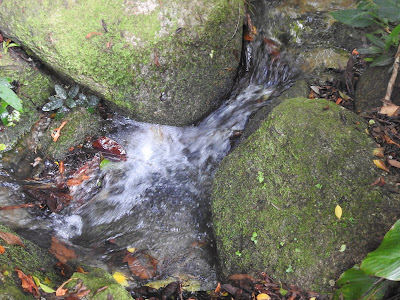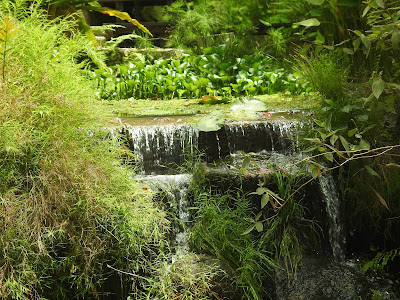Hello again friends
I am still thinking about the savoury food I had in Penang the other day. So hot and spicy and so satisfying, so special. I think the right word to use for it is authentic. Why their curry was so special it must be because of the spices they used. The taste was greatly enhanced due the unique combination of the different spices. That must be their closely and jealousy guarded trade secret. That is why you keep going to the same restaurant ( never mind the walking) although there are many more restaurants or food stalls around the area.
For us doing the everyday cooking at home we only use the standard curry powder in packets which are found sold at the sundry shop. They are mass produced and surely they must contain food additives and preservatives and their volume is made up with non-spice ingredients like rice or may be corn or wheat flour. So usually our curry just tastes ordinary, bland and without punch if you know what I mean. You thought you did everything right yet you don't get that wow . . .
In the old days my mother used to mix and grind her own spices.Coriander seeds made up the volume. Other spices in the right proportions including the the very hard dried turmeric which had to be banged first with the stone roller against the slab to break it before starting the grinding proper. We sometimes mistook it for our mother's expression of anger ha ha.
It was hard work for my mother when grinding spices using the ancient manual grinder which was a combination of a big and heavy stone roller and a slab.
First she would put the wet spices on the slab. Then she would break the spices by banging it with the roller. In between wiping off her sweat she would then with much energy pushed and pulled the roller on the slab until the spices were finely ground and most of the paste stuck onto the roller in neat layers. The technique to get the paste to stick on to the roller was to lift up the roller slightly as you pull it. This is of course easily said than done.
Then with her hand she would lovingly scrap and scoop and carefully formed the paste into a ball twice the size of a tennis ball.
With that and other correctly matching ingredients she then would expertly cook the curry in an earthen ware pot.
As she
tumis the aroma would be released from the spices that sometimes made our neighbor called out in a sing song way voooiiii
masak gulai apa tuuuuu . . . .
And the curry would taste perfect.
The right and clever use of spices makes all the difference.
 |
| The roller and the slab make the batu giling |
Indeed without spices food is tasteless. And without spices there is no varieties in life.
From time immemorial spice is a commodity being sought after by humans. They had gone to war because of spices. People had died protecting their spices. Some people were bullied off their spices.
Today we get spices in packets ready to cook. We hardly know the individual spices that made up our curry powder, bryani powder or
asam pedas mix and so on. I think if we know the specialty of each type of spices we can concoct our own mixture and give the dishes we cook more punch and make it unforgettable.
On my trip on the hop on hop off bus if you remember I mentioned that we made a stop at the spice garden. I was expecting to see the plants that produce some of the familiar spices. But no it was more of the tropical spices and herbs. Except for the black pepper plants I don't remember coming across any coriander or cumin plant. Oh ya there are cinnamon trees.
So tropical spice and herbs mean plants like the torch ginger turmeric or the
laksa leaves. And rightly so the place is called tropical spice garden.
Though I didn't get to see what I really want to see it was still worth while visiting the place. It was quite a big area it looked like a forest in my
kampung when the environment was not yet being tempered.
After paying the entrance fee we were each given an audio guide. As you walk to each of the spot you just switch on the audio and a clear recorded voice will explain what you are looking at. But mind your steps haa because the hilly terrain is carved out into terraces and at some points there are wooden board walk, stepping stones crossing the pond, shallow steps and climbs. Other than that it really was quite safe. By the way do not use high heels.
 |
| Mind your steps |
As nature lovers we didn't mind spending time there. It took us nearly two hours to cover the spice terraces in a relaxed manner while trying to learn the names of the trees and plants there. I should feel a shame being as old as I am I do not know much except for some which are so commonly found outside.
Below is the stevia plant, I have never seen or taste it before but have read about it being a substitute for sugar usually by the diabetics. There were very few of these plants but you can get the dried stevia leaves sold in plastic packets in their souvenir shop located at the end of the spice trail.
 |
| Stevia plant |
Below is the
belimbing buluh. Oh no we didn't come all the way here for the
belimbing buluh. It's just that I found the fruits to be so much bigger smoother and yellow in color unlike those from the tree at home. They looked like plastic.
Below is the cinnamon tree protected with netting lest some one would be tempted to harvest the bark.
 |
| Cinnamon a spice we can't do without |
 |
| This lily plant has medicinal value |
 |
| Nutmeg tree |
 |
| Where is the vanilla plant? |
 |
| The Gaharu for perfume |
 |
| Red bark tree |
Below are more photos randomly taken as we walked up and down the spice trail
 |
| Like trays in the water |
As you can see from the last picture the tropical spice garden is right alongside the the Batu Ferringhi main road. I took this picture while waiting for the hop on hop off bus to take us back to Gurney Drive where we had to change on to another bus that ply the city route and the hotel where we stayed The Royale Bintang is just so near to the bus terminal. It was so convenient.
Hope you enjoy reading. See you in the coming entry.
Bye . . .























































